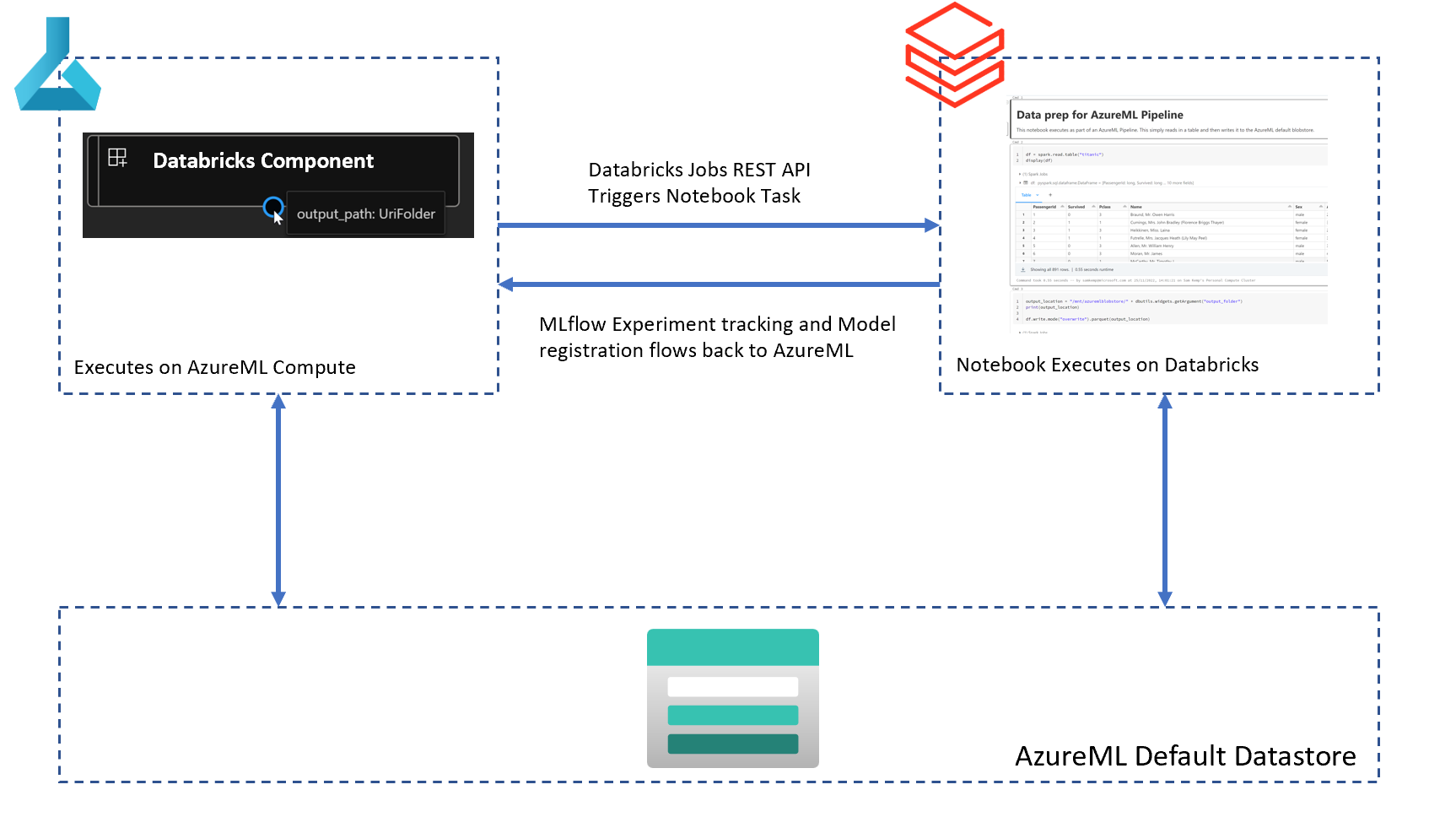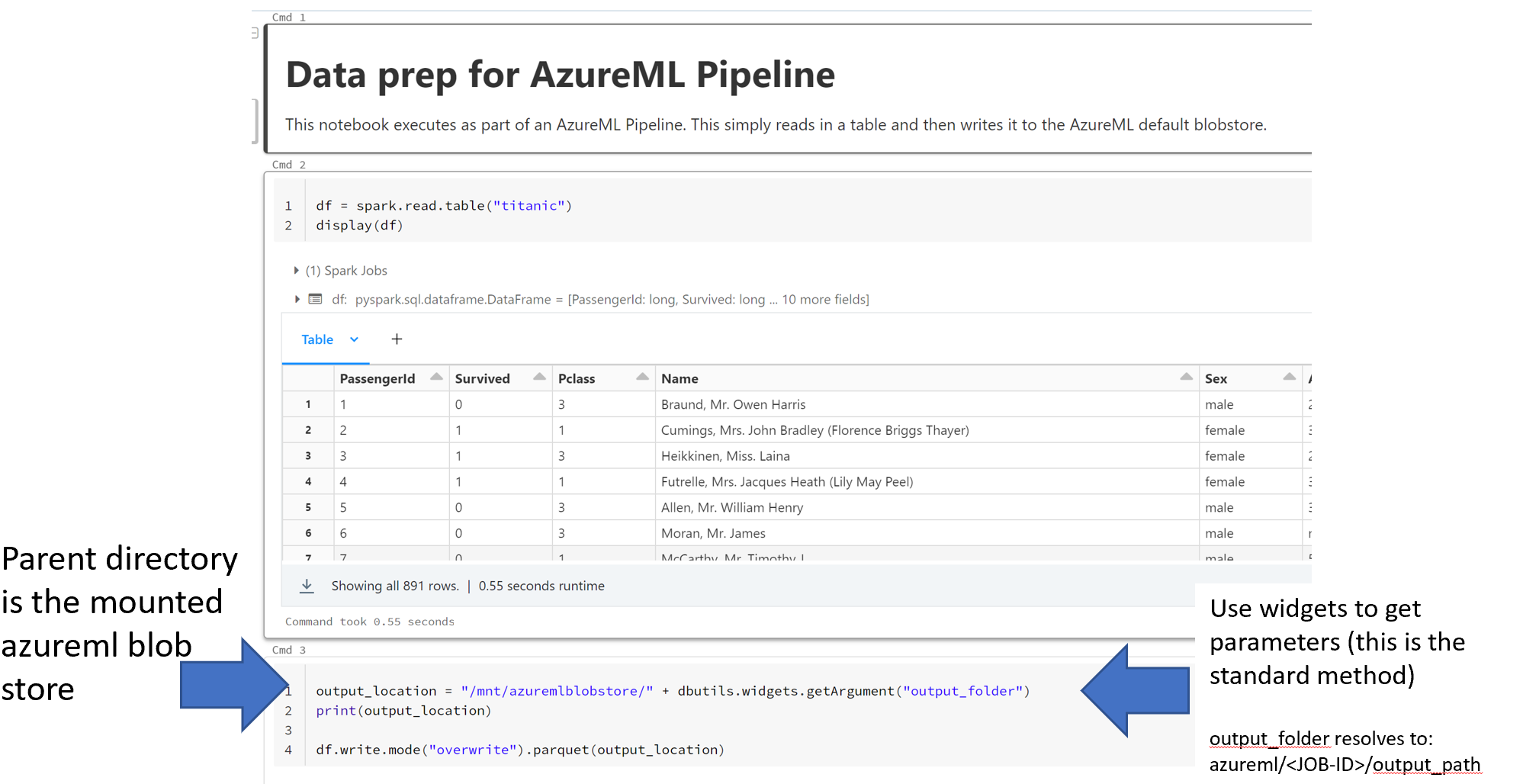This repo demonstrates how you can create AzureML Component that will execute a notebook in your Databricks workspace using the Databricks REST API. You can consume this component in an AzureML pipeline so that you can orchestrate Databricks jobs as part of your workflow - for example, to access data in your Databricks Tables and/or pre-processing of data.
AzureML Pipelines write intermediate data to the default AzureML Workspace Blob storage container. Therefore, you need to mount this in Databricks using:
container_name = "azureml-blobstore-<id>"
storage_name = "<storage-name>"
uri = f'wasbs://{container_name}@{storage_name}.blob.core.windows.net'
blob_config = f'fs.azure.account.key.{storage_name}.blob.core.windows.net'
dbutils.fs.mount(
source = uri,
mount_point = "/mnt/azuremlblobstore",
extra_configs = {blob_config:dbutils.secrets.get(scope = "<scope-name>", key = "<key-name>")})Generate a personal access token (PAT) in Databricks. If you are unsure how to do this, please follow Generate a personal access token. In your AzureML Key vault, create a secret called ADBPAT that stores your PAT:
az keyvault secret set --name ADBPAT --vault-name <AzureMLKeyVault> --value <databricks-pat-token>NOTE To set and access Key vault secrets you should assign a Key vault access policy to:
- your AAD and
- the managed identity of your AzureML Compute Cluster.
To call the Databricks REST API with Python in your component, you'll need an AzureML environment that contains:
- Databricks CLI Python library to programmatically manage various Azure Databricks resources.
- Azure Keyvault and Identity Python Libraries to securely connect to and manage your Databricks PAT token.
To create your Databricks environment in AzureML, execute the following in a terminal:
cd ./azureml-sdkv2-databricks/databricks-component
az ml environment create -f databricks-environment.yml --version 1To create the Databricks component, execute the following commands in your terminal:
cd ./azureml-sdkv2-databricks/databricks-component
az ml component create -f databricks-component.yml --version 1The databricks-component.yml file defines the specification of the Databricks component:
$schema: https://azuremlschemas.azureedge.net/latest/commandComponent.schema.json
type: command
name: execute_databricks_notebook
display_name: Execute Databricks Notebook
description: Execute a notebook as a Spark job in databricks
code: ./src
environment: azureml:databricks:1
command: >-
python databricks_control.py
--databricks-host ${{inputs.databricks_host}}
--notebook_path ${{inputs.notebook_path}}
--keyvault-url ${{inputs.kv_url}}
--keyvault-secret-name ${{inputs.kv_secret_name}}
--num-workers ${{inputs.num_workers}}
--node-type-id ${{inputs.node_type_id}}
--spark-version ${{inputs.spark_version}}
inputs:
databricks_host:
type: string
notebook_path:
type: string
kv_url:
type: string
kv_secret_name:
type: string
num_workers:
type: integer
node_type_id:
type: string
spark_version:
type: string
outputs:
output_path:
type: uri_folder
mode: directThis component will take in a number of parameters such as the Databricks host name, number worker nodes, the Databricks runtime, etc. On AzureML compute, it will then execute the command python databricks_control.py. The databricks_control.py Python script uses the databricks-cli library to initiate a (notebook) task in Databricks, and will output a folder of parquet data.
To run a notebook (or python file/jar/sql task/dbt task) using the databricks-cli Python library requires 3 steps:
- Connect to Databricks using
ApiClient. - Specify the databricks job definition. For example, the cluster size, Spark version, libraries to install, init scripts, etc
- Submit the job run using the
RunsApi.
import argparse
import time
import os
from azure.identity import DefaultAzureCredential
from azure.keyvault.secrets import SecretClient
from databricks_cli.runs.api import RunsApi
from databricks_cli.sdk import ApiClient
# Parse arguments
parser = argparse.ArgumentParser()
parser.add_argument("--databricks-host", type=str)
parser.add_argument("--notebook_path", type=str)
parser.add_argument("--keyvault-url", type=str)
parser.add_argument("--keyvault-secret-name")
parser.add_argument("--num-workers", type=int)
parser.add_argument("--node-type-id", type=str)
parser.add_argument("--spark-version", type=str)
args = parser.parse_args()
# generate the output path. AzureML pipelines use the default datastore
# to store the intermediate outputs. The form of the path that is used
# is azureml/<RUN-ID>/<NAME_OF_OUTPUT>. The name of the output in the component
# is output_path, which is specified in the component yaml file:
# outputs:
# output_path:
# type: uri_folder
# mode: direct
OUTPUT_PATH = os.path.join('azureml', os.getenv('AZUREML_RUN_ID'), 'output_path')
# Get the Databricks personal access token from Key Vault
print("getting secret from key vault...", end=" ")
credential = DefaultAzureCredential()
client = SecretClient(vault_url=args.keyvault_url, credential=credential)
secret = client.get_secret(args.keyvault_secret_name)
print("done")
# Connect to Databricks using ApiClient
print("creating databricks api client...", end=" ")
api_client = ApiClient(host=args.databricks_host, token=secret.value)
print("done")
# Create the Databricks Jobs specification according to
# https://docs.databricks.com/dev-tools/api/latest/jobs.html
job_spec = {
"name": os.getenv('AZUREML_RUN_ID'),
# create a new (on-demand) cluster to run the job
"new_cluster": {
"spark_version": args.spark_version,
"node_type_id": args.node_type_id,
"num_workers": args.num_workers,
# passthrough the AzureML MLFLow details so that tracking is done
# in AzureML
"spark_env_vars":{
"MLFLOW_TRACKING_URI": os.getenv('MLFLOW_TRACKING_URI'),
"AZUREML_RUN_ID": os.getenv('AZUREML_RUN_ID'),
"MLFLOW_EXPERIMENT_ID": os.getenv('MLFLOW_EXPERIMENT_ID'),
"MLFLOW_TRACKING_TOKEN": os.getenv('MLFLOW_TRACKING_TOKEN'),
"MLFLOW_RUN_ID": os.getenv('MLFLOW_RUN_ID'),
"MLFLOW_EXPERIMENT_NAME": os.getenv('MLFLOW_EXPERIMENT_NAME')
}
},
# Run a notebook - it is possible to run other task types too, for
# example a python script/jar/SQL/dbt task.
"notebook_task": {
"notebook_path": args.notebook_path,
"base_parameters": {
# resolves to azureml/<RUN-ID>/output_path
"output_folder": OUTPUT_PATH
}
},
# libraries to install on the cluster. Here we install the azureml-mlflow
# library so that we can use the AzureML MLFlow tracking store.
"libraries": [
{
"pypi": {
"package": "azureml-mlflow"
}
}
]
}
# Submit the Run
print("submitting databricks run...", end=" ")
runs_api = RunsApi(api_client)
run_id = runs_api.submit_run(job_spec)["run_id"]
print("done")
# Wait for the run to complete
my_run = runs_api.get_run(run_id)
while my_run["state"]["life_cycle_state"] != "TERMINATED":
my_run = runs_api.get_run(run_id)
print(f'state of run {run_id} is {my_run["state"]["life_cycle_state"]}')
time.sleep(10)The above code is capable of running any notebook as a notebook task, which means the component can be re-used for different notebooks, cluster sizes, etc by changing the input parameters. However, you may want to make your component more specific. For example, if the intent of your component is to process specific Spark Tables in Databricks and output specific data, you'll probably want to encapsulate that in the component with the optimized Spark settings).
An example databricks notebook is provided, which takes a Databricks Spark Table and outputs it to parquet in the AzureML default blobstore:
The key part of this notebook is the last cell:
output_location = "/mnt/azuremlblobstore/" + dbutils.widgets.getArgument("output_folder")
print(output_location)
df.write.mode("overwrite").parquet(output_location)Here the /mnt/azuremlblobstore is the mount point of the AzureML workspace blobstore defined in the set-up. The widget gets the argument output_folder which was defined in the Databricks component. The output_location will resolve to /mnt/azuremlblobstore/azureml/<RUN-ID>/output_path.
An example AzureML pipeline to execute a Databricks notebook can be found here. The pipeline is created using the V2 SDK:
from azure.ai.ml.dsl import pipeline
from azure.ai.ml import load_component
databricks = ml_client.components.get(name="execute_databricks_notebook", version="1")
train_model = load_component("./train_component.yml")
@pipeline()
def my_pipeline_with_databricks():
adb = databricks(
databricks_host="https://adb-<number>.<2digitnumber>.azuredatabricks.net/",
notebook_path="/Users/<user_name>/<notebook_name>",
kv_url="https://<keyvault_name>.vault.azure.net/",
kv_secret_name="<secret_name_for_databricks_token>",
num_workers=2,
node_type_id="Standard_D3_v2",
spark_version="7.3.x-scala2.12"
)
adb.outputs.output_path.mode = "upload"
train = train_model(data=adb.outputs.output_path)
pipeline_job = my_pipeline_with_databricks()
# set pipeline level compute
pipeline_job.settings.default_compute = "cpu-cluster"The pipeline has two steps:


